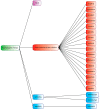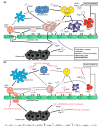New Insight into Therapies Targeting Angiogenesis in Hepatocellular Carcinoma
- PMID: 31370258
- PMCID: PMC6721310
- DOI: 10.3390/cancers11081086
New Insight into Therapies Targeting Angiogenesis in Hepatocellular Carcinoma
Abstract
Hepatocellular carcinoma (HCC) is a malignancy characterized by neoangiogenesis that is determined by an augmented production of proangiogenesis factors by tumor and adjacent cells. This unbalanced angiogenesis process is a key feature of HCC carcinogenesis and progression. Proangiogenic factors also have a relevant role in the generation and maintenance of an immunosuppressive tumor microenvironment. Several therapeutic options for HCC treatment are based on the inhibition of angiogenesis, both in the early/intermediate stages of the disease and in the late stages of the disease. Conventional treatment options employing antiangiogenic approaches provide for the starving of tumors of their blood supply to avoid the refueling of oxygen and nutrients. An emerging alternative point of view is the normalization of vasculature leading to enhance tumor perfusion and oxygenation, potentially capable, when proposed in combination with other treatments, to improve delivery and efficacy of other therapies, including immunotherapy with checkpoint inhibitors. The introduction of novel biomarkers can be useful for the definition of the most appropriate dose and scheduling for these combination treatment approaches. The present review provides a wide description of the pharmaceutical compounds with an antiangiogenic effect proposed for HCC treatment and investigated in clinical trials, including antibodies and small-molecule kinase inhibitors.
Keywords: HCC; angiogenesis; immunotherapy; small-molecule kinase inhibitors.
Conflict of interest statement
The authors declare no conflict of interest.
Figures



References
-
- Cassier P.A., Fumagalli E., Rutkowski P., Schöffski P., Van Glabbeke M., Debiec-Rychter M., Emile J.F., Duffaud F., Martin-Broto J., Landi B., et al. European Organisation for Research and Treatment of Cancer EASL-EORTC clinical practice guidelines: Management of hepatocellular carcinoma. J. Hepatol. 2012;56:908–943. - PubMed
Publication types
Grants and funding
LinkOut - more resources
Full Text Sources

